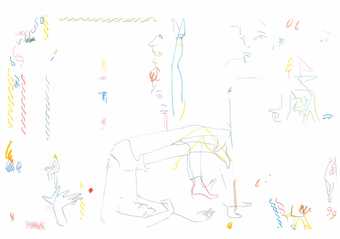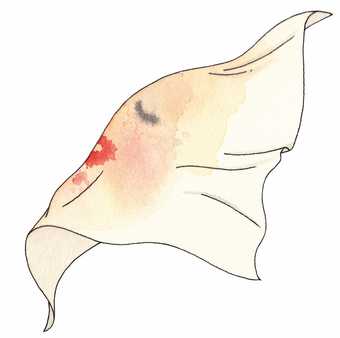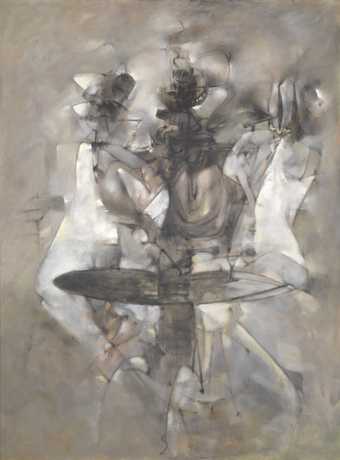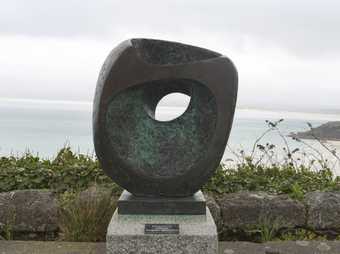
Dame Barbara Hepworth
Pelagos
(1946)
Tate
Earlier this year I visited Barbara Hepworth’s Pelagos 1946 at Tate Britain. Carved from elm and resting on a square base of oak, the sculpture is similar in size to a basketball. In contrast to its exterior, which is polished to a nut-brown sheen, the inner plane is painted a pale matt blue redolent of calm seas and cloudless skies. Lengths of string connect its inner and outer edges. Woven through holes in the work’s swooping wave-like arms, they create a focal point of fraught connection in an otherwise continuous and indivisible form. From her home at Carbis Bay, where she moved with her husband, the painter Ben Nicholson, in 1939, Hepworth would have gazed across the bay of St Ives on a daily basis. That view was the inspiration for Pelagos. The title is Greek for ‘sea’.
For Hepworth, the strings in the sculpture expressed ‘the tension I felt between myself and the sea, the wind or the hills’. Having recently returned from a trip to west Cornwall, I read them differently. They did not speak of the interplay of ego and landscape so much as the banal, problematic, but ultimately indispensible and generative business of getting from A to B. Strings are a symbol of infrastructure. Standing in front of Pelagos, which in Tate is airlessly housed in a Perspex box, I did not muse upon Hepworth’s masterful appreciation of geological form. I thought about trains and motorways. How else did she get to St Ives?
It is impossible to overstate the importance of connections in Cornwall. The most meaningful ones do not exist between individuals and their environment, or artists and their geographical muses, so much as between communities. The county’s contemporary arts scene has many centres, but it is not centralised. As such, it lives and dies on the strength of its connections. Those narrow, winding, tractor-clogged roads, which sprawl across west Cornwall in an intricate cat’s cradle of transport, can feel excruciatingly slow and convoluted. Yet they are essential to Cornish culture. Art in Cornwall is a circulatory system: a network of connections – ‘lifelines’, as one curator referred to them – that enable people to move between points in a constellation, from galleries to studios to living rooms.
To observe that its art scene is geographically dispersed is, in one sense, perfectly self-evident. West Cornwall is a peninsula, not a city. It is predominantly rural. Rainwashed, craggy and elemental, the landscape is marked by its sheer cliffs, fractal creeks and arresting ocean views – and equally, if less famously, its radar stations, naval bases, sprawling supermarkets and decommissioned quarries. The savage grandeur of Penwith both invites and prohibits exploration, tempting would-be walkers down narrow coastal paths only to blast them with horizontal, gale-force rains. Infrastructure is essential to this rugged corner of the world. A minicab driver put it to me bluntly: ‘In Cornwall, if you can’t drive, you might as well have no legs.’
Yet many people here don’t drive – they can’t afford to. Cornwall, the poorest county in Britain, is chronically underserved by public transport. The buses, where they exist, run a few times a day, at most. Trains consist of the Great Western Railway, which is offensively overpriced, and the pottering St Ives Bay Line, the circular logo of which was inspired by Hepworth’s Pelagos. It is not surprising that in Cornwall, more than anywhere else I have visited, journeys fulfil a social as well as practical function. A car becomes a salon on wheels, a vehicular confessional booth in which to reflect and converse (and bicker and whinge – we’re only human, after all) about art, life, politics and other people. Transport connections acquire a significance that, at times, feels almost miraculous. Something is being woven and re-woven here: a grand tapestry of invisible strings. You could call it community.
When they aren’t driving to raves in Kynance Cove or on Durgan beach, students at Falmouth University might road-trip to St Ives to take part in a peer-led discussion group or catch a private view. Artists living in St Just zip through a vascular system of skinny, crazily inclined roads on high-powered motorbikes to reach film screenings and author talks in Helston. People who own cars set up Facebook groups, such as the aptly named Pasty Connection, to pool trips across Cornwall and further afield. Young writers cram into a creaky Citroën 2CV to rattle through the winding roads of the Lizard Peninsula, seeking out an art gallery in a converted farmstead. The vitality of Cornwall’s art scene is not to be found in its art-historical heritage, but in the living, breathing interconnections – the car rides and the bus trips – that make it all possible. Strings express tension, but harmony too.

Motor-ette drawing by France-Lise McGurn for Tate Etc. issue 40 layout, pp.108–9
Patrick Langley is a writer based in London and a contributing editor at The White Review.
The Art Writers Group promotes the development of critical writing about the visual arts throughout the South West region. Their current programme of commissions and events in west Cornwall is run in collaboration with Tate Etc., Tate St Ives, Newlyn Art Gallery and the Exchange and CAST. It is supported by Arts Council England.
France-Lise McGurn is an artist based in Glasgow. Her stairwell commission, Collapsing New People, made during a residency as part of the Tate St Ives Artists Programme, is on display at Tate St Ives until May 2018.



